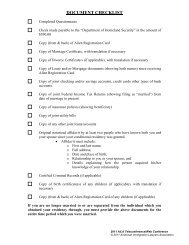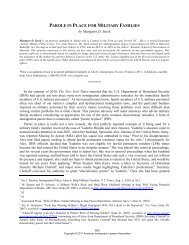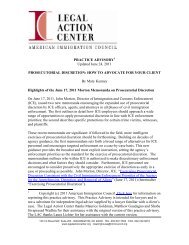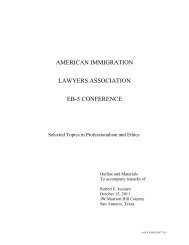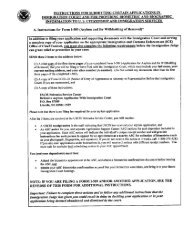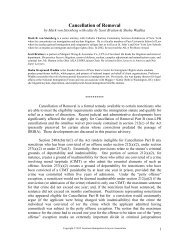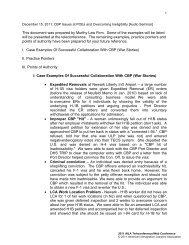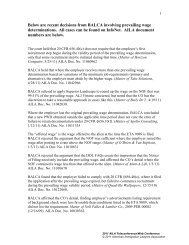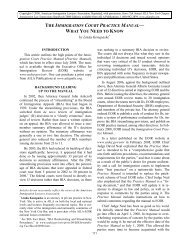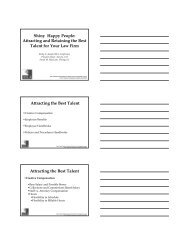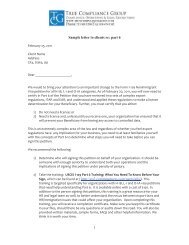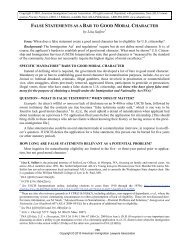Resources for 04-26-11 Seminar - AILA webCLE
Resources for 04-26-11 Seminar - AILA webCLE
Resources for 04-26-11 Seminar - AILA webCLE
You also want an ePaper? Increase the reach of your titles
YUMPU automatically turns print PDFs into web optimized ePapers that Google loves.
WAC 07 277 53214Page 15the critical legislative actions. 8 Considering that counsel hangs the majority of the argument on Congress'intent to "liberalize" the specialized knowledge classification in 1990, the absence of this discussion is asurprising omission.The L-1 intracompany transferee visa classification was created by Congress through the Immigration Act of1970. Pub.L. 91-225, § 3, 84 Stat. <strong>11</strong>7 (Apr. 7, 1970). Congress created the L-1 visa classification afterconcluding that "the present immigration law and its administration have restricted the exchange anddevelopment of managerial personnel from other nations vital to American companies competing in modemdayworld trade." To address the problem, Congress created the L-1 visa and noted that the "amendmentwould help eliminate problems now faced by American companies having offices abroad in transferring keypersonnel freely within the organization." See generally H.R. Rep. No. 91-851 (1970), reprinted in 1970U.S.C.C.A.N. 2750, 2754,1970 WL 5815 (Leg. Hist.).Congress did not define "specialized knowledge" in the Immigration Act of 1970, nor was it a term of artdrawn from case law or from another statute. 1756, Inc. v. Attorney General, 745 F.Supp. 9, 14 (D.D.C.,1990).The legislative history of the Immigration Act of 1970 does not elaborate on the nature of a specializedknowledge employee; instead the House Report references executives, managers and "key personnel."Regarding the intended scope ofthe L-1 visa program, the House Report indicates:Evidence submitted to the committee established that the number of temporary admissionsunder the proposed 'L' category will not be large. The class of persons eligible <strong>for</strong> suchnonimmigrant visas is narrowly drawn and will be carefully regulated and monitored by theImmigration and Naturalization Service.H.R. Rep. No. 91-851, 1970 U.S.C.C.A.N. at 2754.In the initial brief submitted on motion, dated December 27, 2007, counsel quoted a heavily alteredsentence fragment from the 1990 legislative history, noting that the 1990 Act "intended to reconcile '[v]aryinginterpretations [of the term 'specialized knowledge' adopted] by INS.'" Petitioner's "Brief in Support ofAppeal" at <strong>11</strong> (December 27, 2007) (alterations in original). In the brief submitted on certification, datedFebruary 28, 2008, counsel failed to discuss or even cite the legislative history of the 1990 Act, despiteholding the director to task <strong>for</strong> "fail[ing] to account <strong>for</strong> the different legislative intent behind the 1990 revisionofthe definition ofspecialized knowledge." Petitioner's "Briefon Certification" at 18 (February 28, 2008).Counsel also submitted a recently published article from Interpreter Releases that purports to discuss thehistory of the L-1B specialized knowledge classification. Austin T. Fragomen, Jr., "Meeting the Standard:Specialized Knowledge Workers and the L-1B Visa Category" 85 No. <strong>11</strong> Interpreter Releases 757 (March 10,2008). Again, this article fails to cite or discuss the legislative history of the 1970 Act and then selectivelyquotes a sentence out of context from the 1990 Act legislative history. Id. at 759. Without discussing theactual text ofthe legislative history ofthe 1970 Act, counsel's arguments are not persuasive.



